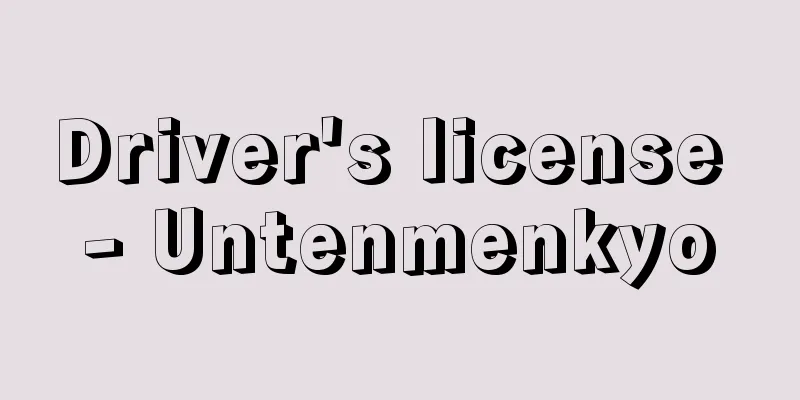Driver's license - Untenmenkyo

|
A legal qualification to legally drive a car or a motorbike. A type of permission under administrative law. Abbreviated as "license." In Japan, it is stipulated in the Road Traffic Act. Driving a car or other vehicle on the road without a driver's license is punishable as unlicensed driving (imprisonment of up to three years or a fine of up to 500,000 yen). As of the end of 2016, there were approximately 82.2 million driver's license holders. [Masahiro Tamura August 21, 2017] typeThere are two types of driver's licenses: a Type 1 license, which is required for normal driving, and a Type 2 license, which is required when driving passengers in passenger automobile transportation businesses (buses, taxis, etc.). There are ten types of Class 1 licenses depending on the type of car: large license, medium license, semi-medium license, regular license, large special license, large two-wheel license, regular two-wheel license, small special license, moped license, and towing license. To drive a vehicle with a total weight of over 750 kilograms attached to the rear of the vehicle and tow it (driving a trailer), you must have a towing license in addition to the license for the car you are driving. Cars are classified according to their total vehicle weight, maximum load capacity, and passenger capacity. Large special vehicles include excavators, and small special vehicles include small agricultural vehicles. Note that these classifications do not match those stipulated by the Road Transport Vehicle Act. A regular driver's license can only drive cars with a total vehicle weight of less than 3.5 tons, a maximum load capacity of less than 2 tons, and a passenger capacity of 10 or less, as well as small special vehicles and mopeds. For non-special vehicles other than two-wheeled vehicles, (1) vehicles with a total vehicle weight of 11 tons or more, a maximum load capacity of 6.5 tons or more, or a passenger capacity of 30 or more, are large vehicles and are subject to a large vehicle license, (2) vehicles with a total vehicle weight of 7.5 tons or more but less than 11 tons, a maximum load capacity of 4.5 tons or more but less than 6.5 tons, or a passenger capacity of 11 to 29, are medium-sized vehicles and are subject to a medium license, and (3) vehicles with a total vehicle weight of 3.5 tons or more but less than 7.5 tons, a maximum load capacity of 2 tons or more but less than 4.5 tons, and a passenger capacity of 10 or less, are semi-medium-sized vehicles and are subject to a semi-medium license. Those who hold these licenses can drive smaller vehicles in addition to the vehicles covered by each license (for example, a medium-sized license allows the driver to drive semi-medium-sized vehicles, regular vehicles, small special vehicles, and mopeds in addition to medium-sized vehicles). On the other hand, motorcycles (including those with sidecars) cannot be driven with a license other than that for motorcycles. Motorcycles with a total displacement of 400cc or more are considered large motorcycles and require a large motorcycle license. In addition, motorcycles with three or more wheels that have the same driving characteristics as two-wheeled automobiles are considered to be two-wheeled automobiles. Motorcycles with a total displacement of 50cc or less (0.6 kilowatts rated output for electric vehicles) are considered "motorized bicycles" and are subject to a moped license. Anyone with a regular driver's license can drive one. Under the Road Transport Vehicle Act, any motorcycle with a total displacement of 125cc or less (1.0 kilowatts rated output for electric vehicles) is considered a "motorized bicycle," but those with a displacement of over 50cc (Class 2 mopeds, commonly known as "Class 2 mopeds") are considered motorcycles under the Road Traffic Act. On the other hand, those that act as an auxiliary force to human power and meet certain conditions (bicycles with a drive assist mechanism (so-called electrically assisted bicycles)) are treated as bicycles and do not require a driver's license. There are five types of Class 2 licenses: Large Class 2 License, Medium Class 2 License, Regular Class 2 License, Large Special Class 2 License, and Towing Class 2 License. Since there is no semi-medium Class 2 license, a medium Class 2 license or higher is required to operate a semi-medium vehicle in a passenger vehicle transportation business. [Masahiro Tamura August 21, 2017] AcquisitionThe ages available for obtaining a large vehicle license are 21 years old, a medium vehicle license is 20 years old, a medium vehicle license is 18 years old, a medium vehicle license is 16 years old, and a large vehicle license is 18 years old. A person must have held a large vehicle license or a second-class license for three years, and a medium vehicle license is 2 years old. The test is for aptitude (eyesight requirements, etc.), skills (excluding mopeds and small special vehicles), and theory, but those who have taken lessons at a designated driving school and passed the skills test are exempt from the skills test. Since the tests for large vehicles, medium vehicles, medium vehicles, and normal vehicles are held on public roads, a provisional license is required to practice and take the tests. The provisional license period is six months, and the person can drive as long as the license holder is seated next to them and instructed, and a sign indicating that the vehicle is for practice is attached. Those who pass the test must be given a driver's license, but those who suffer from certain illnesses may be denied a license or have it withheld for a certain period of time. In addition, for regular driving licenses, etc., one must have taken an initial training course in order to obtain the license (in the case of a moped license, one must have taken a moped training course that includes practical training on how to ride, etc.). [Masahiro Tamura August 21, 2017] driver's licenseDriver's licenses are issued by the Prefectural Public Safety Commission that has jurisdiction over the person's place of residence. The license holder's address, name, date of birth, type of license, and conditions (for example, whether or not they wear glasses. In addition, those who held a regular license during the period when a regular license allowed drivers to drive vehicles up to 8 tons are, in principle, limited to a medium-sized license of up to 8 tons), etc. are listed, and an image of the person's face is displayed. It is made into an IC card, and the person's registered domicile and nationality are not printed on the front. The license must be carried when driving a car, etc. In principle, a driver's license is valid for five years (until one month after the driver's birthday), but for first-time renewers, those with multiple (or serious) violations, and those aged 71 or older at the time of renewal, the validity period is three years. Renewal must be completed within two months before the expiration date. At the time of renewal, an aptitude test is conducted, and renewal courses are held for good drivers (those who have had no accidents or violations for five years and are marked as good on their license; also known as "gold licenses"), general drivers, drivers with violations, and first-time renewers. Seniors (over 70 years old) are required to have attended a senior citizen course in order to renew. [Masahiro Tamura August 21, 2017] Driver's license penaltiesIf a person violates the Road Traffic Act after obtaining a license and accumulates a certain number of points, the driver's license will be suspended. If a person commits a serious violation or causes a serious traffic accident, the prefectural public safety commission will revoke the driver's license. In addition, people who suffer from certain illnesses may be subject to revocation or suspension of the license. [Masahiro Tamura August 21, 2017] [Reference items] | | | | | | |Source: Shogakukan Encyclopedia Nipponica About Encyclopedia Nipponica Information | Legend |
|
自動車および原動機付自転車を適法に運転することのできる法的資格。行政法上の許可の一種。「免許」と略称される。日本では道路交通法に規定されている。運転免許がないのに自動車等を道路で運転することは、無免許運転として処罰される(3年以下の懲役または50万円以下の罰金)。2016年末の運転免許保有者数は約8220万人である。 [田村正博 2017年8月21日] 種別運転免許には、通常の運転に必要な第一種免許と旅客自動車運送事業(バス、タクシー等の事業)で旅客を乗せて運転する場合に必要となる第二種免許とがある。 第一種免許は、自動車等の車種に応じて、大型免許、中型免許、準中型免許、普通免許、大型特殊免許、大型二輪免許、普通二輪免許、小型特殊免許、原付免許、牽引(けんいん)免許の10種類がある。車両の後部に総重量750キログラムを超える車を連結して、引きながら運転する(トレーラーを運転する)には、運転する車の免許に加えて、牽引免許を受けていなければならならない。自動車等は車両総重量や最大積載量、乗車定員などによって区分される。大型特殊自動車とはショベルカーなど、小型特殊自動車とは小型の農耕作業車などである。なお、道路運送車両法による区分とは一致しないことに注意を要する。 普通免許で運転が可能なのは、車両総重量が3.5トン未満かつ最大積載量が2トン未満かつ乗車定員10人以下の自動車と、小型特殊自動車および原動機付自転車に限られる。二輪以外の特殊でない自動車の場合、(1)車両総重量11トン以上、最大積載量が6.5トン以上または乗車定員30人以上のものは大型自動車で大型免許の対象、(2)車両総重量7.5トン以上11トン未満、最大積載量が4.5トン以上6.5トン未満または乗車定員11人以上29人未満のものは中型自動車で中型免許の対象、(3)車両総重量3.5トン以上7.5トン未満、最大積載量が2トン以上4.5トン未満、乗車定員10人以下のものは準中型自動車で準中型免許の対象となる。これらの免許を受けた者は、それぞれ対象の自動車のほか、より小さな自動車の運転が可能である(たとえば中型免許では、中型自動車のほか、準中型自動車、普通自動車、小型特殊自動車、原動機付自転車の運転が可能である)。他方、自動二輪車(側車付の場合を含む)については、二輪以外の免許では運転できない。総排気量400cc以上のものは大型自動二輪車であって、大型二輪免許を要する。なお、三輪以上でも走行の特性が二輪の自動車と同様のものは、二輪の自動車とみなされる。 総排気量50cc(電動の場合は定格出力0.6キロワット)以下の二輪車は、「原動機付自転車」として、原付免許の対象となる。普通免許等を保有していれば、運転が可能である。道路運送車両法では、総排気量125cc以下(電動の場合は定格出力1.0キロワット以下)までを「原動機付自転車」としているが、50ccを超えたもの(第二種原動機付自転車。通称「原付二種」)は、道路交通法上は自動二輪車に該当する。一方、人の力に対する補助力として作用するもので一定の条件を満たしたもの(駆動補助機付自転車(いわゆる電動アシスト自転車))は、自転車として扱われ、運転免許を要しない。 第二種免許には、大型第二種免許、中型第二種免許、普通第二種免許、大型特殊第二種免許および牽引第二種免許の5種類がある。準中型二種免許は設けられていないため、準中型自動車を旅客自動車運送事業で運行するには中型二種以上の免許が必要である。 [田村正博 2017年8月21日] 取得取得可能な年齢は、大型免許は21歳、中型免許は20歳、準中型免許・普通免許・大型特殊免許・大型二輪免許・牽引免許は18歳、普通二輪免許・小型特殊免許・原付免許は16歳である。大型免許および第二種免許は、普通免許等を受けていた期間が3年、中型免許は2年なければ受験資格がない。試験は、適性(視力要件等)、技能(原付および小型特殊を除く)および学科について行われるが、指定自動車教習所で教習を受け、技能検定に合格した者は、技能試験が免除される。大型、中型、準中型および普通の試験は公道で行われるので、その練習および試験等を受けるために、仮免許を受けなければならない。仮免許の期間は6月間、免許保有者が横に同乗してその指導を受け、練習等であることを示す標識をつけていれば、運転をすることができる。試験に合格した者には運転免許を与えなければならないが、一定の病気にかかっている者等については、免許が拒否され、あるいは一定期間保留される場合がある。このほか、普通免許等については、取得時講習を受けていることが免許取得の要件とされている(原付免許の場合は、走行方法等についての実技訓練を含めた原付講習を受けていなければならない)。 [田村正博 2017年8月21日] 運転免許証運転免許は、住所地を管轄する都道府県公安委員会が運転免許証を交付して行う。免許を受けた者の住所・氏名・生年月日、免許の種別、条件(たとえば眼鏡の着装。そのほか、普通免許で8トン未満までの運転が認められていた時期に普通免許を保有していた者は、原則として、中型免許で8トン未満とする限定が付されている)等が記載され、本人の顔画像が表示される。ICカード化され、本籍・国籍は表面に記載されないようになっている。自動車等を運転するときは免許証を携帯していなければならない。 運転免許証の有効期間は、原則として5年間(誕生日の1か月先の日まで)であるが、初回更新者および複数(または重い)違反歴のある者ならびに更新時に71歳以上の者については3年となる。有効期間が満了する前の2か月の間に、更新をしなければならない。更新時には、適性検査が行われるほか、優良運転者(5年間無事故無違反で、免許証に優良と表示される。「ゴールド免許」ともよばれる)、一般運転者、違反運転者、初回更新者の別に更新時講習が行われる。高齢者(70歳以上)については高齢者講習を受けていることが更新の要件となる。 [田村正博 2017年8月21日] 運転免許上の処分免許取得後に道路交通法等に違反する行為をし、累積点数が一定の基準に該当した者は、運転免許の効力の一時停止の処分を受ける。重大な違反をした場合または重大な交通事故を起こした場合には、運転免許の取消し処分が都道府県公安委員会によって行われる。このほか、一定の病気にかかっている者については、取消しや効力の一時停止の対象となる場合がある。 [田村正博 2017年8月21日] [参照項目] | | | | | | |出典 小学館 日本大百科全書(ニッポニカ)日本大百科全書(ニッポニカ)について 情報 | 凡例 |
Recommend
Palmas
…Today, castanets are often used in flamenco perf...
The Greyhound Corp.
A holding company that includes the largest bus co...
Ibadan - Ibadan (English spelling)
Oyo is the capital of Oyo State in western Nigeri...
Narrow vowel - semaboin
〘Noun〙 In phonetics, a vowel pronounced with the t...
Leontes
…the river flows through southern Lebanon. It is ...
Caribbean monk seal (English spelling) Monachus tropicalis; West Indian monk seal
Order Carnivora, Suborder Pinnipedia, Family Phoci...
Aizu Five Yakushi
...The layout of the temple buildings in the old ...
premiere danseuse (English spelling) premiere danseuse
…Example: Afternoon of a Faun. Premiere danseuse:...
Jussi Björling
1911‐60 Swedish tenor. He gained musical experienc...
Baiko Onoe (6th) - Onoe Baiko [6th]
Born: October 15, 1870 (Meiji 3), Nagoya [Died] No...
Insulinoma
…If blood sugar naturally falls below 60 mg/100 m...
Sebaldus
... When cities were first established, they were...
Uchihirame - Uchihirame
…There are also Sakai (Sakai) coins, which indica...
Casal, J.
…A prehistoric site located in southeastern Afgha...
Asian Damselfly - Asian Damselfly
…The yellow dragonfly Ceriagrion melanurum (illus...



![Ukiha [town] - Ukiha](/upload/images/67cafb85abc8d.webp)





